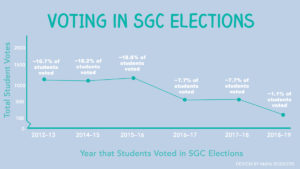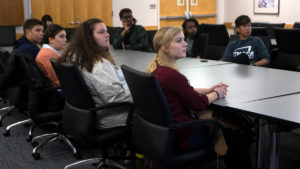A disconcerting trend has been manifesting at Ithaca College: Fewer and fewer students are voting in Student Governance Council executive board elections, and senate vacancies are becoming more common.
A variety of possible factors could have contributed to this drop in student engagement with SGC. Many SGC executive board positions have run uncontested, which may cause apathy toward voting in elections. This political apathy may also be cultivated by a feeling that the campus climate has improved. Additionally, a lack of interest in getting involved could be derived from students not feeling represented by the SGC.
When comparing the college’s voting rates of student government elections with peer institutions, voter turnout for SGC elections is notably lower. In 2017, 7.7 percent of students at the college voted in the race for the executive board. In 2018, this decreased to 1.1 percent of the student body. Even other schools that saw a decrease in voter turnout over the past year retain higher student engagement than the college. At Quinnipiac University, 46 percent of its undergraduate students voted in the 2017 student government election, and over 33 percent voted in the 2018 student government election.
Other peer institutions also saw comparatively high rates of voter turnout in student government elections in 2018. At Drake University, 14 percent of the student body voted in the 2018 student government election, at Elon University, 42.4 percent voted in the 2018 election and at Hamline University, 39.3 percent voted in the 2018 election. Elon University was the only election at the peer institutions that was uncontested.
W.H. Oxendine Jr., executive director of the American Student Government Association, said the national average of voter turnout for student government elections ranges from 15 to 20 percent, based on data collected by the ASGA.
Student engagement in the past
The current historically low levels of engagement with campus politics come three years after the biggest protests the college has ever experienced — many of which were led and organized solely by students. One of the largest demonstrations in Fall 2015, led by the student group POC at IC, which stands for People of Color at Ithaca College, was attended by over 1,000 students, which is over 13 times the number of students who voted in the last race for SGC executive board. Approximately 6,900 students attended the college that year.
The organization POC at IC, was formed in response to the administration’s lacking response to several racially charged incidents on campus approximately three weeks prior to this demonstration. During that same month, the SGC executive board organized a vote of no confidence against former college President Tom Rochon. A total of 54 percent of the student body responded to the vote. Ultimately, 71.75 percent of the students who responded to the survey said they had no confidence in Rochon, and the SGC executive board presented the results to over 300 students in Emerson Suites. Rochon announced his retirement a few months later.
Even at the height of campus unrest, Dominick Recckio ’16, SGC president during the 2015–16 academic year, still noticed a lack of student interest in other actions taken by the SGC outside the vote of no confidence. As another means of addressing student concerns with college administration, the SGC passed the Student Bill of Rights and Responsibilities. This bill was discussed at the same meeting as the results of the vote of no confidence but to a comparatively empty room, Recckio said. Students were far more engaged in ousting Rochon, and many left Emerson Suites once the results of the vote of no confidence were released.
“By the time the Student Bills of Rights was passed, that room only had 50 people in it compared to 300 and some it had before,” Recckio said. “I think that’s really indicative too, even in the craziest, most intense times, students didn’t want to engage as much with the policy or the outcomes.”
In the 2015–16 SGC executive board race, 18.9 percent of the total student body voted in the election, which had five full executive boards running for the position.

The most significant drop in student engagement with the SGC occurred in 2016 following Rochon’s announcement of his resignation that January. During Spring 2016, the SGC struggled to meet quorum — the minimum number of senators needed to vote on bills — three meetings in a row. The 2018–19, 2017–18 and 2016–17 executive boards all ran unopposed, and voter turnout dropped sharply. In 2016 and 2017, voter turnout for the executive board race was 7.7 percent of the student body. In 2018, it dropped to 1.1 percent of the student body.
As executive director of the American Student Government Association, Oxendine hosts leadership seminars for student government organizations. He has also published several books on the role of student government on college campuses. In his experience, he said, a student government organization often experiences low levels of engagement because it is not regarded as the true voice of the students. Voter turnout is one way to measure this perception of the student governance.
“The bigger problem is that they’re not seen as effective,” Oxendine said. “When you’re effective, and you have influence, and you ultimately have power, people want to be a part of that. … Low voter turnout is an indicator of a big problem. … Voter turnout is the proof that you really are representative. If you’re at 1 percent, you’re not representative. You’re a club.”
Moving forward
The current SGC executive board, elected in Spring 2018, ran on a platform that emphasized student and senate engagement as a priority. Senior Kylee Roberts, SGC vice president of communications, said the executive board plans to increase student awareness about the upcoming fall election primarily through social media.
“We feel like we’re not really on a lot of people’s radars, which was a big part of our campaign going in,” Roberts said.
The official SGC Facebook page has received 1,005 likes since its creation in 2010. There are 6,769 students enrolled at the college currently. The page’s most recent post, created Sept. 5, advertising the organization’s upcoming Fall 2018 election, currently has no likes as of Sept. 9. A similar post on the organization’s Twitter page also has no likes or retweets.
The dip in student engagement with SGC could also be partially influenced by increased student satisfaction with the college and administration, Recckio said. The college had a positive reaction to Rochon’s successor, current college President Shirley M. Collado. Collado was announced as president in February 2017 and began her tenure in July 2017. Senior Carlie McClinsey, SGC president during the 2017–18 academic year, also expressed this sentiment and said this trend could be an indicator of an improved campus climate.
Oxendine said that in his experience working with student government, he has seen the opposite effect from a shift in upper–level leadership. Usually, during the first few years, a “honeymoon” phenomenon occurs, during which student government organizations collaborate with new administrators and pique the interest of the student body, Oxendine said.
Just as Recckio and McClinsey said decreased student engagement with SGC may be at least partially a result of an improved perception of the college, Michele Lenhart, director of the Office of Student Engagement, said this may also affect the number of uncontested races. Students will not be as motivated to run for SGC positions if they aren’t as concerned about the direction of the college, which in turn directly impacts student voter turnout, Lenhart said.
“The voter turnout for SGC elections has been directly related to the number of people running for office,” Lenhart said. “In my opinion, if more students run for the open positions, the elections will attract more voters and be a better representation of the students’ voices.”
Sophomore Tiffany Daniel-Ramsey said she was not aware of the Spring 2018 election, but even if she had been, the large number of uncontested candidates would have dissuaded her from voting.
“There’s no point for me to vote if there’s only one person running — we know they’re going to win by default anyways,” Daniel-Ramsey said. “If there was another candidate or a couple of other candidates, maybe I would’ve voted.”
Even beyond the engagement of the larger student body, the SGC has also struggled to attract and maintain engaged senate members.
The SGC is going into its 2018 fall elections looking to fill 19 senate vacancies as well as the executive board position of senate chair. This large number of vacancies following spring elections is not unprecedented. Prior to the 2017 fall election, the SGC had 16 open senate positions, and going into the 2016 fall election SGC had 12 vacancies to fill.

The SGC holds two elections per year — one in the late spring and another in the early fall. The executive board is always elected in the spring election along with some senate positions. Additional senators are elected to fill any vacancies the following fall.
With the current vacancies, the SGC has 4 senators out of 24 total positions. There is no specification in the SGC constitution on the minimum number of senators needed to hold a meeting or pass bills.
Senior SGC President Alyse Harris said the current executive board is not concerned about the possibility of a significant number of senate vacancies following the fall election because issues of meeting quorum have been resolved in the past. As stated in the SGC constitution, a quorum is two-thirds of the total senate body. If none of the senate vacancies are filled during the fall election, the SGC would need seven senators for any voting to occur during a meeting.
“We haven’t really been thinking about what would happen if nobody ran because that wouldn’t be a positive mind state to be in,” Harris said. “We’re really hoping to get a lot of really awesome engaged people, and if it came down to it we would look into the policy on that … but it really rarely comes up because we are always able to make quorum and get enough people participating.”
Some SGC positions are historically more likely to be filled than others. The graduate student liaison and varsity sports senator, for example, have been unoccupied for the last four semesters. Other positions, such as the School of Humanities and Sciences and Park School senators, have been consistently filled the last four semesters.
Harris said these populations that often do not have a senate on the SGC can still be represented by other senators who may overlap in their roles on campus. For example, even without a graduate liaison, graduate students may be represented by a senator within their schools.
“Certain senate positions may be consistently unoccupied because of the responsibilities already expected of these populations prior to joining SGC,” McClinsey said. For example, students such as varsity athletes often have schedules and obligations that conflict with the expectations of SGC senators, who must not only attend weekly meetings but also join at least two campus committees.
Junior John Bailey said he is familiar with SGC and did not vote in the spring election because he was abroad. However, Bailey said he does not engage with the organization because he hasn’t been aware of any impact SGC has had on the campus or him personally.
“We don’t really see any of the campaigns or anything like that,” Bailey said. “We don’t see any effect, which is why I haven’t been super interested in it.”
Senior Morgan Gjoen said she does not have a full grasp of the purpose or significance of SGC and its role on campus. Gjoen did not vote in the Spring 2018 election and was not aware that it occurred.
“I feel like I don’t really know what the student governance, whatever it’s called, is” Gjoen said. “I feel like I get a lot of emails, and I’m kind of just like, whatever. It probably impacts me, but I don’t see it impacting me. I have so many other things to worry about — like the lack of actual presence of it is why I didn’t feel the need to vote.”








